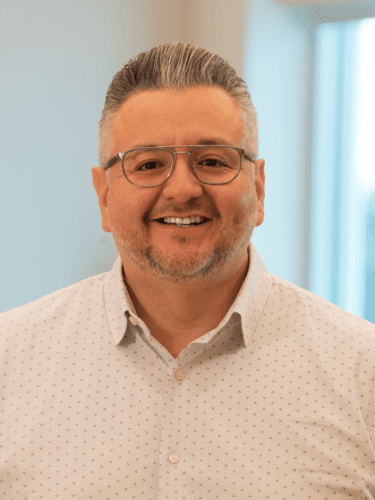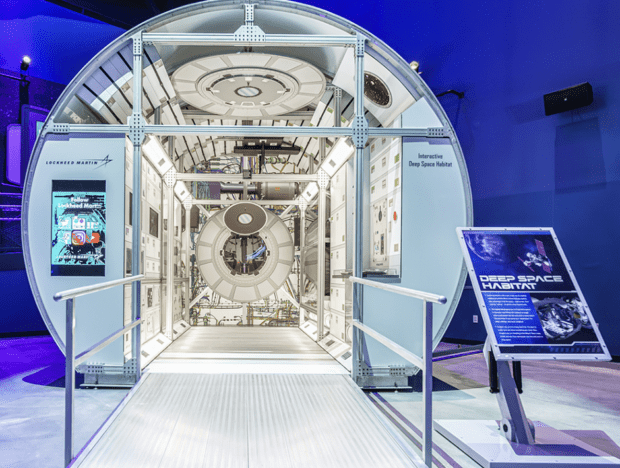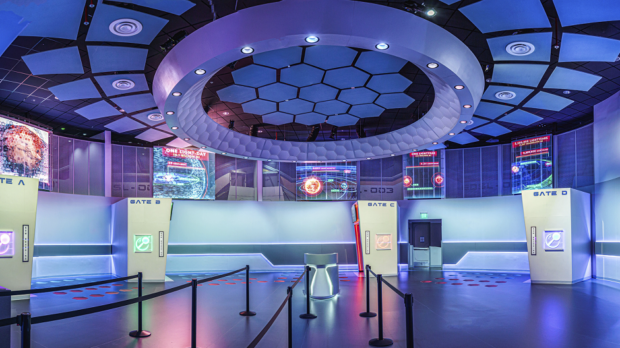Q&A: Meet two of the architects responsible for Gateway: The Deep Space Launch Complex
Gateway: The Deep Space Launch Complex opened at the Kennedy Space Center Visitor Complex on June 15, 2022. Francisco Alvarado and Robert Bartlett were two of the principal architects who helped make the whole thing happen.

Photos courtesy of Kennedy Space Center Visitor Complex
What does it take to bring state-of-the-art space-based education and entertainment into being, with a heaping helping of cutting-edge technology, a massive SpaceX rocket booster, and the challenges of pandemic chaos thrown in for good measure?
Francisco Alvarado, vice president & principal, and Robert Bartlett, senior architect & principal, took us through the process, from concept to completion.


Where did the idea for Gateway come from?
Robert: Our counterparts at Delaware North have long been keen to provide a strong entertainment element, but hand-in-hand with an educational experience for their guests at the Visitor Complex. It’s not simply entertainment, it’s not simply education. Early on, Delaware North was interested in introducing a ride experience, and they had a preliminary concept in mind, so we worked with them and developed an initial concept. Soon after that began, their partners at NASA expressed a desire to have a better showcase for a lot of their artifacts they currently have, but needed a better forum to display those. The previous location was – I’ll call it “humble.” They identified an opportunity to bring these two things together. Then it became a challenge of marrying these two very strong components into one shared experience.
We ultimately changed the ride vehicle concept to this four-theater spaceport concept that we have now that would be located adjacent to an exhibit hall that is there to showcase current flight hardware, unlike the other buildings that showcase significant programs of the past – Shuttle, Apollo, Gemini. [It connects the dots, conceptually, between things that are flying today and the springboard into the future, and just up this ramp you can go into these theaters that give you a glimpse at what could just be right around the corner.
How long did it take to put together the plan for the exhibit and how long was the construction process?
Robert: A very, very long period. We first started meeting back in 2017, trying to kindle the fires and tease the story out of how these things work together, and tell a story that’s understandable and compelling and enjoyable for the guests. It was a couple of years in development before it gelled into a concept.

What challenges did you run into having to put everything together in the middle of a pandemic?
Francisco: I’m really proud of the way our team, Delaware North, NASA, and the contractors all really worked together. Almost two and a half years ago, we didn’t know how it was going to end up. At that time, we were in the process of beginning construction, and we were hoping to make quick headway, and Covid certainly did delay that construction. How do we perform something that requires a lot of face-to-face time in the field to review items while keeping everyone safe? Safety is very important. It’s one of our core values at BRPH.
It was a challenge. Just because we’re under construction, the design work doesn’t end. There are always additional tweaks that we’re looking to make, and the owners are looking to make to improve and make the best of the project. We were all working remotely from home, and that created its own challenges. Our team was able to overcome that, and we adapted to the new way of working. It was a full team effort and everyone deserved credit.
BRPH, the architect and engineer that designed Gateway, has worked on a series of iconic theme park attractions in recent years. Does Gateway signify that the KSC Visitor Complex is looking to create more of a theme park atmosphere?
Robert: There is probably a lot of truth in that. [Kennedy Space Center Visitor Complex] is very proud of the high guest satisfaction reports they get back, so they are going to guard that very carefully and try to build on that, so it wouldn’t surprise me if in future you saw more things that are more physical experiences for their guests, such as this.
Francisco: In general, the public loves roller coasters and rockets, and while the Visitor Complex doesn’t have roller coasters inside their park, they certainly do have a lot of rockets. They’re now marrying that with our entertainment team and what we’re doing with the theme park work. […] While it may seem this is a step in having more attraction-level works instead of just exhibit space, at the root I don’t think they’re going to change that. The goal for NASA is always to use the Visitor Complex as a way to educate the public about the amazing work that NASA has done in the past, and what they’re going to be doing in the future. I think it’s a perfect mixture of educating the public, but doing it in a way that is a little bit more immersive than just an exhibit hall. It’s not looking at it as experiences that are more thrills, or coaster-type; maybe what the Visitor Center is looking for is more immersive experiences.

The SpaceX rocket booster was obviously a huge piece of equipment to have to incorporate inside the building – was it a nerve-racking process to get it installed?
Francisco: For us architects, it’s very exciting. If you ask our structural engineers, they’re probably the ones who are a little bit more nervous. Our team spent a lot of time modeling it to make sure all the clearances were going to be clean, and it is tricky. It is very captivating when you walk into that space. It does definitely draw your eye to that and you [can’t help] but look up. […] After it was erected, I think we all felt a sense of accomplishment and relief.
Robert: It was certainly a thrilling moment. Still a bit of anxiety, because despite our measuring and measuring and measuring, we were still holding our breath to be certain that the darned thing was going to fit in. It’s an enormous vehicle. The building looks large from the outside and it takes up every bit of it. That was a little nerve-wracking; a delicate dance for the installation team to get it through the wall that was intentionally left off the building, drive it into the building, raise it up into position, get the nose pitch just the way that you need it to fit in. It was surgery on a very large scale, and it was at the high point of hurricane season, too. Everybody was looking at the Atlantic Basin to make sure we weren’t going to have company any time soon.
Parts of the technical aspect of the building aren’t likely to register with or even be seen by many guests, but what are you most proud of with those aspects that aren’t immediately obvious?
Robert: We were determined to set up views so that the guests come upon the various artifacts in a dramatic and memorable way, and we set up a few key moments inside the building where you can really appreciate these things and see them set in a beautiful ensemble. Once you’ve gone through the theater and you’re returning back into the exhibit hall, there’s a moment when you’ve got a new view of the exhibits that you hadn’t seen previously. If you’re paying attention, you get a new excitement and a new appreciation for the things you’re seeing, having gone through your flight to outer space. It should pull it all together and help complete the story.
How did the four theater-based space journeys come about?
Robert: We had some initial storyboards that were developed, and then Delaware North took that and worked with their own vendors and story-writers and content creators and developed those stories. Understanding that the destinations may change, it was on us to create a framework in which those stories could plug in. The narrative is that this is a spaceport of tomorrow, so we designed it and pillared it as if you’re walking into that spaceport of tomorrow and you might want to go to Mars, but your companion might want to go to a distant nebula. It’s all compatible to that.
The stories of the different missions were developed independent of us at a certain branching-off point, and they took those and ran with them. We were given previews along the way just to make sure everything was compatible, and it worked out very well. We were very pleased with the end results.


BRPH’s work with the theme parks is also extremely widespread, but is there a project there that you are especially pleased with?
Robert: What we call the concourse, which is the space that you enter into that distributes the guests into the four various theaters, we were very pleased with the way that turned out. It’s loaded with state-of-the-art technology, and overhead there are some LED screens that are translucent, so as guests pass into the theaters you can actually see movement through these screens. I’ve never had the privilege of having something that high-tech on a project of mine. You really feel like you’ve taken a step into the future.
Francisco: For me, it’s seeing our team and the others regarding all the different exhibits. While it was challenging, because sometimes we didn’t know what the exhibits were going to create, I love the challenges. I thrive on that. Seeing the technology that ended up being used in those exhibits, and working with the owner talking about the different technology they wanted to incorporate, and throwing those ideas back and forth with them, was really rewarding and really interesting.
There are sneaky ways of everyone of all ages to learn throughout that facility, and that, to me, is where the fun is. The guests come in and they start tinkering, and they press a button and say, “Oh, wow! You can do this here…!” As designers, as architects, we love seeing that kind of reaction from guests, and finding that exploration within themselves.

What other theme-park based projects has BRPH worked on?
Francisco: We supported SeaWorld in the Sesame Street land that they’ve done in Orlando, Disney’s Remy’s Ratatouille Adventure, we’ve done Hagrid’s Magical Creatures Motorbike Adventure and a lot of work with Universal, starting back with Dueling Dragons.
We have engineers that were working early in their career, and now they’re seasoned veterans, and they say, “You know you’re getting old when the attraction that you worked on when you were a young engineer is now being torn down and you’re working on the replacement.”
Robert: …Transformers:The Ride-3D, Race Through New York Starring Jimmy Fallon…
Francisco: Fast & Furious – Supercharged. For Disney, the Jungle Cruise – we supported the engineering on that project. We like working with the theme parks. BRPH as a company is one that doesn’t shy away from challenges, whether it’s a creative challenge that a lot of these theme park projects tend to bring because they’re trying to design and build a ride that probably hasn’t been done before, or whether it’s a technical challenge like designing a new launch pad for a commercial space company. We thrive, as a company, off of those challenges. We love the hard work.

